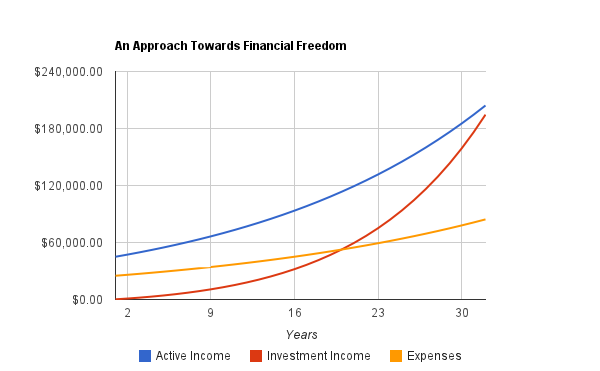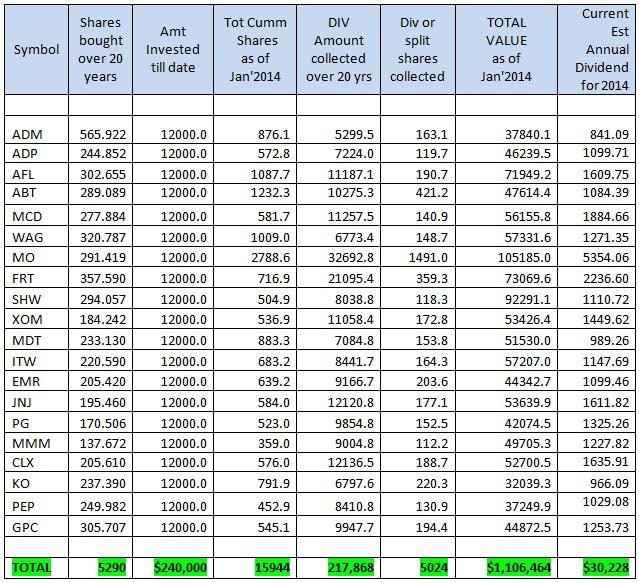Using Dividends For Passive Income In Retirement
Post on: 14 Май, 2015 No Comment

written by Hank Coleman
My father-in-law was a bank executive for over thirty years at a large regional bank in the United States, and he amassed quite a bit of his company’s stock through options over his career. Now, in addition to his pension, he also has quarterly dividends that support him in retirement. That is the beauty of dividends. They are truly a passive income investment in most cases, and they can often help you to get more out of your finite investment resources than other options allowing you to more efficiently save for retirement.
How Much Do You Need?
I used to watch the share price of my father-in-law’s bank like a hawk. It gave me something great to talk to him about when the conversation lagged around the dinner table. I was amazed after a particularly brutal quarter of share price decline when he told me that he did not care because he was not interested in selling his shares. He only wanted the dividend and the security that the payments brought him in retirement. How much do you need in dividend paying stocks to simply live off the dividends during retirement?
Here is a simple example to give you an idea. Let’s say that you originally were earning $50,000 per year. Most financial experts recommend that you need investments that either produce an income or allow you draw them down slowly and provide you with 80% of your pre-retirement income. So, in our example, you would need $40,000 per year or $3,333 per month in retirement. If you owned dividends yielding 5% annually, you would need a nest egg of $800,000 to produce that amount of income. I know that the number sounds big at first glance but please stick with me. It gets better.
Dividends Help You Catch Up With Retirement Savings
One of the best advantages of dividend stocks is that most some have an average annual yield of 5%, most with a dividend yield of 3% to 4%, which is considerably more than government bonds and most other fixed income securities. For example, if you needed to generate $3,333 per month in income from a portfolio of 10-year US Treasuries which currently yield on 2% annually, you would need a portfolio of $2 million to produce that income level. Having dividend paying stocks that yield 5% or better each year just saved you from the need to save $1.2 million over the course of your lifetime. And, of course, things do not look much better when you look at Canadian government 10-year bonds yielding under 2% too, and inflation continues to eat away at fixed income gains as well. You do not have to take a considerable amount of risk with very high yielding dividend stocks in order to out perform Treasuries. Consistent blue chip dividend paying companies can save you a bundle and significantly reduce your retirement nest egg costs.
How To Get Going If You Are Behind
Okay, so things aren’t quite as bad as they seemed when I first started telling you the numbers. You need to save and invest $800,000 in dividend paying stock instead of $2 million for low earning treasuries in order to earn the passive income needed in retirement to replace your working salary. But, how are you going to get to that magical $800,000 number? Talking about large numbers like this tend to make people’s heads spin, but does not need to be that way. It can be done. Nest egg totals such as this can be reached. Here are a few tips to help you get there.

- Start as early as possible – Time is the best thing that you have on your side when starting to invest. Starting early allows you do harness the power of compounding interest and dividends.
- Pay yourself first – Make it a point to set aside money specifically for dividend stocks in your budget and make that a top priority before you pay for other items from your budget.
- Make your dividend investing automatic – DRIPs are an excellent way to consistently invest each month a specific dollar amount on a set day of the month or even multiple days of each month.
- Reinvest your dividends – One of the best ways to continue growing the number of shares that you own is by reinvesting the dividends. Historically, reinvested dividends contribute a healthy portion of the stock market’s historic return.
- Continue to add to your positions – This almost goes without saying, but you should continue to look for new dividend paying stock to invest in when the opportunity arises.
Using these methods will give you the best opportunity to reach the nest egg value that you need in retirement in order to produce passive income through your dividends. While some of these final numbers may seem daunting at first, it can be achieved through diligent planning, sticking to your plan, and continuing to invest to build your dividend paying nest egg.
Related Posts
Subscribe
If you enjoy reading the Dividend Ninja, don’t forget to also subscribe and get the Ninja delivered right to your inbox (and if you don’t like it – subscribe anyway). Thanks for reading!














